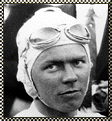
by Michael J. Rollins
Frank Lockhart -- born in Cleveland on April 8, 1903 and raised in southern California - arrived in Indianapolis in 1926 in a cloud of obscurity and left a champion under a cloud of rain.
Lockhart was a known entity in driving circles in 1926, but had no car to drive at the Indianapolis Motor Speedway. He did so well during practice as a relief driver that when Peter Kreis was unable to drive on race day, May 31, because of the "flu," car owner Harry Miller wisely put Lockhart in the No. 15 car.
Everything was set for the 14th running of the Indianapolis 500 except the weather. Undeterred, racing fans were there from all points of the compass. The usual long lines of cars were waiting at the speedway entrances, all night long, and there was the usual congestion on the streets leading to racing's Mecca.
Despite the meteorological threats, the drivers took their starting positions; Earl Cooper on the pole, Harry Hartz in the middle and Leon Duray on the outside of row one. Kreis had qualified Miller's car in the middle row seven. Lockhart would be starting in the 20th position.
The pace car, a new 1926 Chrysler Imperial '80' roadster driven by Louis Chevrolet, led the field. Starter Seth Klein dropped the green flag and the race was on. Hartz took the lead on the first lap, closely followed by Cooper and Duray. By lap three, Lockhart had moved up to fifth position overtaking 14 cars on that lap alone. In the process, Lockhart established a record of 120.918 m.p.h. for a competitive lap. Dave Lewis took the lead and Lockhart moved up from third to second position on lap 16. After the 20th revolution, the race was between Lewis and Lockhart. Lewis pitted on lap 59 and Lockhart took the lead, which he held through lap 71, when the race was stopped because of rain.
More than an hour later the race restarted and Lockhart completed the 72nd lap in the lead. Lewis and Lockhart took turns leading for the next 20 laps until Lewis was forced from the competition. From then on Lockhart never relinquished the lead, improving his position steadily. Rain fell again, however, and on lap 160, starter Klein waved the red flag, which stopped the race and gave Lockhart a place in history. He won in 4 hours, 13 minutes and 37.58 seconds, averaging 94.63 m.p.h.
Lockhart won four more championship car races in 1926, proving the rain-shortened Indy win was no fluke. He went on to win the 25-, 50- and 150-mile races at Charlotte, NC, and the 250 mile-race at Altoona, PA.
The next year, Lockhart won the 200-mile race at Altoona, the 25- and 50-mile races at Charlotte, and the 65- and 75-mile races at (Rockingham) Salem, NH, for a total of nine AAA wins in two years.
With Stutz Motor Car Company sales sagging, Frederick Moskovics felt he needed someone to stir up some publicity and interest in the Stutz car. Frank Lockhart was just that person. During 1927 Frank Lockhart established a world record of 164.28 miles per hour on the dry lakes of Muroc, CA; in a car powered by a tiny 91 1/2 cubic-inch displacement engine. This established Lockhart as one of the most competent and skilled drivers in automobile racing.
Lockhart's success was due largely to his inherent engineering ability and the ability to make changes necessary to make a racing car go faster. The specially built Stutz "Blackhawk Special" in which Lockhart was to make the assault on the world speed record was a product largely of his own creation and was considered a masterpiece of engineering.
The most recent holders of world speed records were established by massive cars, powered by two or more aircraft-type engines, having piston displacements up to 4,900 cubic inches. The Stutz "Blackhawk Special" was in every respect much smaller, being powered by one 16-cylinder engine (two banks of 8 cylinders, set at an included angle of 30 degrees), having an only 181 cubic-inch displacement.
During the trial run at Daytona Beach on Feb. 22, 1928, at a speed of approximately 225 m.p.h., the tires apparently struck an irregularity in the sand and catapulted the "Blackhawk Special" end over end into the sea. Lockhart was rescued from the water by spectators, and was uninjured except for a few bruises and traumatic shock. The "Blackhawk Special" was retrieved and sent back to Indianapolis for repairs. The car was rebuilt and returned to Daytona in April 1928 for the next try for the world speed record.
On Wednesday, April 25, 1928, Lockhart again was shooting for the world speed record when the car went into a skid as it approached the timing wire. Lockhart's machine again tumbled tumbled end over end. The car finally came to rest 140 feet down the beach, with Lockhart's lifeless body 51 feet from where the car stopped.
Lockhart's tragic death was devastating to the motorsports community, especially to the Stutz Motor Car Company, which declared a halt to all its racing activities.